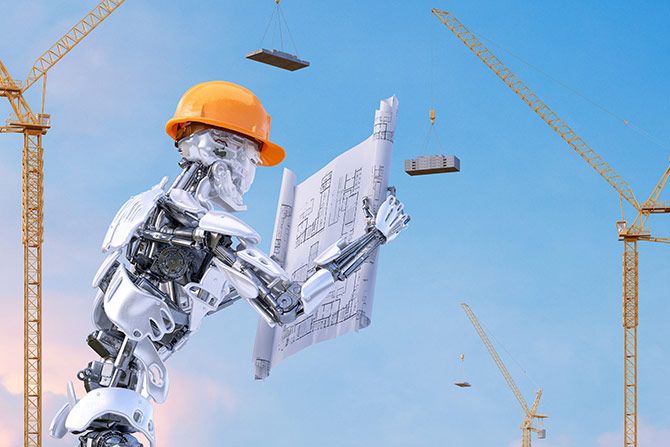ABC’s Tech Alliance
ABC’s Tech Alliance was built to help members develop people, win work and deliver that work safely, ethically and profitably for the betterment of the communities in which ABC and its members work through improved utilization of technology.
The alliance is a hand-selected group of 15 construction technology companies that add inherent value for ABC members and position ABC as a leading association for construction technology needs.
Led by Matthew Abeles, ABC vice president of construction technology and innovation, the alliance companies will be integrated into the association’s long-term planning. The companies will collaborate on technology resources for the association, including a beta testing/free technology program and educational webinars focused on our mid-size contractors and provide chapters with access to companies supporting our contractor members.
To learn more about the ABC Tech Alliance, please go to https://www.abc.org/Technology/Tech-Alliance.
Cybersecurity Tips
In today’s digital age, cybersecurity is a top priority for businesses across all industries, including construction. It is important to protect your data and sensitive information. That’s why Associated Builders and Contractors (ABC) provides a wealth of resources to help members become Cybersecurity Maturity Model Certification (CMMC) compliant and stay informed about the latest cybersecurity trends and best practices.
Become CMMC Compliant
https://www.abc.org/Portals/1/Welcome%20To%20CMMC%202.0%20Handout.pdf?ver=HwaethBdcseZNJ9zPHHFcw%3d%3d
Access Cybersecurity Webinars
https://www.abc.org/academy/entryid/19938
Cybersecurity News and Insights
https://www.abc.org/Technology/Cybersecurity-Resource-Guide
AI in Construction
What Does It Mean for Our Contractors?
Artificial intelligence (AI) is revolutionizing the construction industry by enhancing efficiency, safety and decision-making throughout the project lifecycle. AI in construction involves the application of advanced technologies like machine learning, computer vision and data analytics to various construction processes. Through AI, machines can learn and imitate human cognitive functions.
The importance of AI technology in construction should not be underestimated. It can help to complete projects on time, minimize staffing challenges, save money and address safety concerns. AI learns from the data provided to it. It can adjust project plans based on the information it receives, allowing decision-makers to alter those plans or change them to improve safety or minimize inefficiencies.
AI can enhance productivity, reduce costs, improve safety and promote sustainable practices, making it a vital tool for the industry’s future growth and development. The possibilities may sound endless, but as an industry traditionally looking from the outside in at technology, we must first step back to educate ourselves on the basics. This resource is meant to act as a starting point in your journey to understand AI and its potential impact on the construction industry. By reading through definitions, construction use cases and considerations, the reader should walk away with a level of knowledge to ensure they can actively participate in future conversations on AI in construction.
Definitions
Artificial Intelligence: Per The National Artificial Intelligence Initiative Act of 2020: “A machine-based system that can, for a given set of human-defined objectives, make predictions, recommendations or decisions influencing real or virtual environments.”
Machine Learning: Application of AI that allows a system to automatically learn and improve from experience. In other words, machine learning helps computers do tasks like recognizing colors, finding pictures of cats on the internet or even suggesting what to watch on TV. It’s like teaching the computer to be smart and make decisions by looking at lots of examples and learning from them. One common example of this is the Large Language Model.
Deep Learning: Per IBM: “Deep learning is a subset of machine learning, which is essentially a neural network with three or more layers. These neural networks attempt to simulate the behavior of the human brain — albeit far from matching its ability — allowing it to ‘learn’ from substantial amounts of data. While a neural network with a single layer can still make approximate predictions, additional hidden layers can help to optimize and refine for accuracy.” Deep learning has achieved remarkable success in various applications, including self-driving cars, medical diagnosis, recommendation systems and more. Its power lies in its ability to automatically learn and adapt to new data, making it a cutting-edge technology in the field of AI and data analysis.
Generative AI: A type of AI that can create new data or content, such as images, text, music or even videos, by learning patterns and structures from existing examples. It works by understanding and mimicking the patterns and styles it has seen in the data it was trained on. The most publicly recognized tool in the last year is ChatGPT, built by the company OpenAI. ChatGPT is an artificial intelligence chatbot that can process natural human language and generate a response. It has revolutionized how we interact with computer systems and has influenced the evolution of AI. Additional generative AI tools from other major technology companies include: Meta’s Llama 2, Microsoft’s Copilot, Google’s PaLM 2, Amazon’s Bedrock and Dall-E 2, also from OpenAI.
Predictive AI: A type of AI that uses data and machine learning algorithms to forecast future events or trends. It helps businesses and organizations make informed decisions by analyzing historical data, identifying patterns and making predictions based on those patterns.
Top 10 Ways to Boost Productivity and Efficiency With AI
- Generative Design and Planning: Generate multiple design alternatives and optimize project plans.
- Predictive Analytics for Risk Management: Predict potential delays, cost overruns and other risks.
- Smart Equipment and Asset Management: Implement AI-driven asset tracking and maintenance systems.
- Autonomous Vehicles and Robotics: Explore AI-powered drones, autonomous vehicles and robotic construction equipment.
- Quality Control and Defect Detection: AI algorithms can detect defects construction materials, structures and finishes.
- Supply Chain Optimization: Optimize material procurement, logistics and inventory management.
- Energy Efficiency and Sustainability: AI can analyze building designs and recommend energy-efficient solutions.
- Safety Monitoring and Compliance: AI-powered cameras and sensors can monitor construction sites for safety compliance.
- Performance Analytics: Analyze project performance data using AI.
- Document Management Automation: Automate document sorting, indexing and retrieval, streamlining communication and ensuring easy access to critical project documentation.
Remember, adopting AI tools strategically can revolutionize the construction industry, leading to better outcomes, reduced costs and safer processes. To learn more, please visit www.abc.org/Technology/AI-Resource-Guide.










